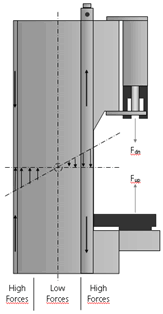A New Paradigm in Crimping Press Design
While traditional crimping press designs work very well, manufacturing costs are often higher than desired. Rob Boyd of Schleuniger explains the benefits of a new paradigm in crimping press design.
 It goes without saying that manufacturing companies want the highest possible quality at the lowest possible cost. These days, everyone is trying to do more with less in order to stay relevant in a competitive environment.
It goes without saying that manufacturing companies want the highest possible quality at the lowest possible cost. These days, everyone is trying to do more with less in order to stay relevant in a competitive environment.
This can be especially true of automatic crimping presses. Conventional designs use thick, steel side-plates or a cast frame in conjunction with a motor and gear box combination. These proven designs work very well; however, manufacturing costs (and therefore end-user pricing) are higher than desired due to very high tolerance requirements for many of the components used in conventional crimping presses. The performance of conventional presses also degrades over time due to the design of the motor and gearbox combination.
 Recently, a radical new design in automatic crimping presses was introduced. The new design created a compact, efficient, and cost-effective press with high process capability and durability. The design is simple, easy to manufacture, and easy to set up and maintain. In addition, the new design takes into consideration application flexibility and integrated crimp force monitoring.
Recently, a radical new design in automatic crimping presses was introduced. The new design created a compact, efficient, and cost-effective press with high process capability and durability. The design is simple, easy to manufacture, and easy to set up and maintain. In addition, the new design takes into consideration application flexibility and integrated crimp force monitoring.
 The frame is made of formed sheet metal rather than solid pieces of heavy steel or a cast frame, and instead of the conventional motor and gearbox combination, a direct belt-drive system is used. A patented ram spring mechanism is incorporated into the press ram, providing excellent consistency and durability. An adjustable press easily accommodates the wide range of crimping applicators on the market.
The frame is made of formed sheet metal rather than solid pieces of heavy steel or a cast frame, and instead of the conventional motor and gearbox combination, a direct belt-drive system is used. A patented ram spring mechanism is incorporated into the press ram, providing excellent consistency and durability. An adjustable press easily accommodates the wide range of crimping applicators on the market.
Frame Design
A comparinson of the different frame designs further explains why the formed sheet metal design was chosen. Cast frames are very low-cost and very rugged; however, volumes must be very high for the initial investment costs to be justified. Welded frame constructions are also very durable, but the manufacturing process is relatively  expensive. Similarly, using heavy, solid steel side plates has been proven as a very durable design. Unfortunately, the manufacturing process has proven to be too expensive due to the required milling and plating processes. Furthermore, it was determined that the solid steel side plate construction is overkill for forces up to 20kN (two tons). The force load distribution over the side plates does not require the same thickness throughout the entire width to achieve the desired results for the target applications.
expensive. Similarly, using heavy, solid steel side plates has been proven as a very durable design. Unfortunately, the manufacturing process has proven to be too expensive due to the required milling and plating processes. Furthermore, it was determined that the solid steel side plate construction is overkill for forces up to 20kN (two tons). The force load distribution over the side plates does not require the same thickness throughout the entire width to achieve the desired results for the target applications.
The forces exerted by the crimping process on the side plates are opposing from front to back. High, outward forces are exerted on the front of the side plates (closest to the applicator). In contrast, lower inward forces are exerted on the back of the side plates. Between the front and the back, the forces cancel. Therefore, it is not necessary to have the same support structure, e.g. side plate thickness, throughout the entire side plate. The formed steel side plates support these forces where they are exerted, in the front and the back.
 At first, building a crimping press out of formed sheet metal seemed to be a radical concept; however, it has been used successfully in other industries. One example is truck frames, which are made of formed sheet metal that supports forces far greater than realized on a crimping press.
At first, building a crimping press out of formed sheet metal seemed to be a radical concept; however, it has been used successfully in other industries. One example is truck frames, which are made of formed sheet metal that supports forces far greater than realized on a crimping press.
Drive Design
 The traditional gearmotor drive design is effective, yet expensive. The gearbox, shaft, and ram coupling must be aligned perfectly to prevent premature bearing wear. Tolerances need to be very tight and these tighter tolerances mean higher prices. Furthermore, if parts are installed incorrectly, components will wear prematurely. Finally, as we all know, mechanical parts inevitably wear over time. After millions of cycles, excess play begins to degrade performance. The challenge in new presses was to design a crimping press that could achieve the same or better durability and precision with a simpler, lower cost design.
The traditional gearmotor drive design is effective, yet expensive. The gearbox, shaft, and ram coupling must be aligned perfectly to prevent premature bearing wear. Tolerances need to be very tight and these tighter tolerances mean higher prices. Furthermore, if parts are installed incorrectly, components will wear prematurely. Finally, as we all know, mechanical parts inevitably wear over time. After millions of cycles, excess play begins to degrade performance. The challenge in new presses was to design a crimping press that could achieve the same or better durability and precision with a simpler, lower cost design.
The implementation of a belt drive makes the design much simpler and, as a result, much easier to manufacture and assemble. Tolerances are less critical because the flexible timing belt will compensate. Because of the looser tolerances, parts are less expensive. An added benefit of this design is that servicing is much easier as well.
A Simple Spring Was the Key
 So how do you get precision from a system that has relaxed tolerances? It is true that relaxed tolerances inherently mean that there is more play in the system. However, the answer was quite simple: a spring. A spring mechanism that compresses all of the excess play at the bottom of the crimping stroke, where the precision is needed most, is key. This simple spring assembly provides considerably better process capability results. Throughout the life of the press, the spring mechanism continues to remove excess play as parts wear. Machine capability and precision remain consistent for a much longer period of time, therefore extending the lifetime of the machine.
So how do you get precision from a system that has relaxed tolerances? It is true that relaxed tolerances inherently mean that there is more play in the system. However, the answer was quite simple: a spring. A spring mechanism that compresses all of the excess play at the bottom of the crimping stroke, where the precision is needed most, is key. This simple spring assembly provides considerably better process capability results. Throughout the life of the press, the spring mechanism continues to remove excess play as parts wear. Machine capability and precision remain consistent for a much longer period of time, therefore extending the lifetime of the machine.
Through external and long-term testing, the new design concepts have proven to provide world-class performance and durability over an extended period of time. Next time you purchase a new crimping press, be sure to take a closer look at the design first: It will ensure you get the most bang for your buck.
[hr]
Rob Boyd is senior product manager at Schleuniger Inc.







